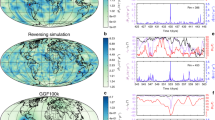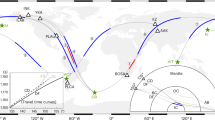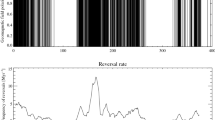Abstract
The Earth’s inner core is believed to inhibit rapid fluctuations in the geomagnetic field from developing into full polarity reversals1,2. Consequently, during the Precambrian, the smaller size of the inner core might suggest that polarity reversals could occur more readily. It is therefore surprising that there are indications that reversals were rare during this period3,4. Here we use new and existing palaeomagnetic data from three continents to examine the stability of the Earth’s magnetic field from 2.82 to 2.45 billion years ago. We show that, on average, geomagnetic secular variation (the field variations produced by normal geodynamo action) during the late Archaean and early Proterozoic was different from that of the past 200 million years; specifically, the apparent variability of the geomagnetic pole as viewed at low and mid-latitudes was reduced relative to the past 200 million years. According to both dynamo simulations4 and more recent palaeomagnetic field observations5, the observed pattern of secular variation suggests a lower frequency of polarity reversals 2.5 billion years ago. This may imply that the geodynamo is becoming progressively less stable over long timescales, consistent with some numerical simulations6,7, possibly as a result of changing outer-core geometry that has accompanied inner-core growth.
This is a preview of subscription content, access via your institution
Access options
Subscribe to this journal
Receive 12 print issues and online access
$259.00 per year
only $21.58 per issue
Buy this article
- Purchase on Springer Link
- Instant access to full article PDF
Prices may be subject to local taxes which are calculated during checkout


Similar content being viewed by others
References
Gubbins, D. The distinction between geomagnetic excursions and reversals. Geophys. J. Int. 137, F1–F3 (1999).
Hollerbach, R. & Jones, C. A. Influence of the earth’s inner-core on geomagnetic fluctuations and reversals. Nature 365, 541–543 (1993).
Roberts, N. & Piper, J. D. A. in Geomagnetism (ed. Jacobs, J. A.) 163–260 (Elsevier, New York, 1989).
Coe, R. S. & Glatzmaier, G. A. Symmetry and stability of the geomagnetic field. Geophys. Res. Lett. 33, 2006GL027903 (2006).
McFadden, P. L., Merrill, R. T., McElhinny, M. W. & Lee, S. H. Reversals of the earths magnetic-field and temporal variations of the dynamo families. J. Geophys. Res. 96, 3923–3933 (1991).
Morrison, G. & Fearn, D. R. The influence of Rayleigh number, azimuthal wavenumber and inner core radius on 2–1/2 D hydromagnetic dynamos. Phys. Earth Planet. Inter. 117, 237–258 (2000).
Roberts, P. H. & Glatzmaier, G. A. The geodynamo, past, present and future. Geophys. Astrophys. Fluid Dyn. 94, 47–84 (2001).
Smirnov, A. V. & Tarduno, J. A. Secular variation of the late Archean early Proterozoic geodynamo. Geophys. Res. Lett. 31doi:10.1029/2004GL020333 (2004).
McElhinny, M. W. & McFadden, P. L. Palaeosecular variation over the past 5 Myr based on a new generalized database. Geophys. J. Int. 131, 240–252 (1997).
Hulot, G. & Gallet, Y. On the interpretation of virtual geomagnetic pole (VGP) scatter curves. Phys. Earth Planet. Inter. 95, 37–53 (1996).
McFadden, P. L., Merrill, R. T. & McElhinny, M. W. Dipole quadrupole family modeling of paleosecular variation. J Geophys. Res. 93, 11583–11588 (1988).
Hulot, G. & Gallet, Y. Do superchrons occur without any palaeomagnetic warning? Earth Planet. Sci. Lett. 210, 191–201 (2003).
Pavlov, V. & Gallet, Y. A third superchron during the Early Paleozoic. Episodes 28, 78–84 (2005).
Courtillot, V. & Olson, P. Mantle plumes link magnetic superchrons to Phanerozoic mass depletion events. Earth Planet. Sci. Lett. 260, 495–504 (2007).
McFadden, P. L. & Merrill, R. T. History of earth’s magnetic-field and possible connections to core–mantle boundary processes. J. Geophys. Res. 100, 307–316 (1995).
Gubbins, D., Alfe, D., Masters, G., Price, G. D. & Gillan, M. J. Can the Earth’s dynamo run on heat alone? Geophys. J. Int. 155, 609–622 (2003).
Labrosse, S. Thermal and magnetic evolution of the Earth’s core. Phys. Earth Planet. Inter. 140, 127–143 (2003).
Lassiter, J. C. Constraints on the coupled thermal evolution of the Earth’s core and mantle, the age of the inner core, and the origin of the (OS)-O-186/(OS)-O-188 ‘core signal’ in plume-derived lavas. Earth Planet. Sci. Lett. 250, 306–317 (2006).
Brandon, A. D. & Walker, R. J. The debate over core–mantle interaction. Earth Planet. Sci. Lett. 232, 211–225 (2005).
Christensen, U. R. & Tilgner, A. Power requirement of the geodynamo from ohmic losses in numerical and laboratory dynamos. Nature 429, 169–171 (2004).
Buffett, B. A. Estimates of heat flow in the deep mantle based on the power requirements for the geodynamo. Geophys. Res. Lett. 29doi:10.1029/2001GL014649 (2002).
Williams, G. E. Geological constraints on the Precambrian history of earth’s rotation and the moon’s orbit. Rev. Geophys. 38, 37–59 (2000).
Vandamme, D. A new method to determine paleosecular variation. Phys. Earth Planet. Inter. 85, 131–142 (1994).
Bates, M. P. & Halls, H. C. Broad-scale proterozoic deformation of the central superior-province revealed by paleomagnetism of the 2.45 Ga Matachewan dyke swarm. Can. J. Earth Sci. 28, 1780–1796 (1991).
Halls, H. C. & Palmer, H. C. The tectonic relationship of two early protorozoic dyke swarms to the Kapuskasing structural zone: A paleomagnetic and petrographic study. Can. J. Earth Sci. 27, 87–103 (1990).
Meert, J. G., Van der Voo, R. & Patel, J. Paleomagnetism of the Late Archean Nyanzian System, Western Kenya. Precambr. Res. 69, 113–131 (1994).
Strik, G. H. M. A., Blake, T. S., Zegers, T. E., White, S. H. & Langereis, C. G. Palaeomagnetism of flood basalts in the Pilbara Craton, Western Australia: Late Archaean continental drift and the oldest known reversal of the geomagnetic field. J. Geophys. Res. 108, EPM 2-1–EPM 2-21 (2003).
Wingate, M. T. D. A palaeomagnetic test of the Kaapvaal-Pilbara (Vaalbara) connection at 2.78 Ga. South African J. Geol. 101, 257–274 (1998).
Tarduno, J. A., Cottrell, R. D. & Smirnov, A. V. The Cretaceous superchron geodynamo: Observations near the tangent cylinder. Proc. Natl Acad. Sci. USA 99, 14020–14025 (2002).
Johnson, C. L. et al. Recent investigations of the 0–5 Ma geomagnetic field recorded by lava flows. Geochem. Geophys. Geosyst.doi:10.1029/2007GC001696 (in the press, 2008).
Acknowledgements
This research was undertaken with funding provided by the Netherlands Science Foundation (NWO) and conducted under the programme of the Vening Meinesz Research School of Geodynamics (VMSG).
Author information
Authors and Affiliations
Contributions
A.J.B. undertook the palaeosecular variation analyses and provided the interpretation. G.H.M.A.S. obtained the newly reported data from the Pilbara Craton and undertook PSV analyses on these. C.G.L. initiated the project and advised and assisted throughout.
Corresponding author
Supplementary information
Supplementary Information
Supplementary figures S1-S4 and table S1 (PDF 521 kb)
Rights and permissions
About this article
Cite this article
Biggin, A., Strik, G. & Langereis, C. Evidence for a very-long-term trend in geomagnetic secular variation. Nature Geosci 1, 395–398 (2008). https://doi.org/10.1038/ngeo181
Received:
Accepted:
Published:
Issue Date:
DOI: https://doi.org/10.1038/ngeo181
This article is cited by
-
Quantitative estimates of average geomagnetic axial dipole dominance in deep geological time
Nature Communications (2020)
-
Paleomagnetic Evidence for Inverse Correspondence between the Relative Contribution of the Axial Dipole Field and CMB Heat Flux for the Past 270 Myr
Scientific Reports (2019)
-
Palaeomagnetic field intensity variations suggest Mesoproterozoic inner-core nucleation
Nature (2015)
-
Paleomagnetism of the Late Cretaceous volcanic rocks of the Shimaoshan Group in Yongtai County, Fujian Province
Science China Earth Sciences (2013)
-
Observations and Models of the Long-Term Evolution of Earth’s Magnetic Field
Space Science Reviews (2010)



